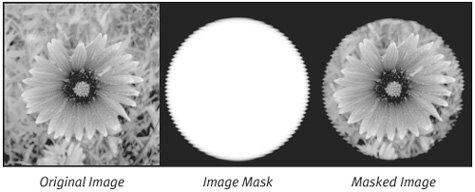What Is an Image?
| Image is a bit of an overloaded term when you apply it to computer graphics. In fact, all of the graphics you create using a computer could be called images. In Core Graphics, however, the term "image" has a specific connotation. If you wanted to be very exact, you might say that in Quartz 2D, an image is defined as a rectangular array of color samples from an associated color space. Returning to the digital camera, for example, the CCD in the camera captures light from a scene and generates a large set of color values (usually RGB) that represent that light. Each RGB triplet is called a color sample. The camera structures these color samples into a large, rectangular array, and computer graphics professionals like to call each sample a picture element (or pixel). The camera generates a big rectangular array of color samples and that matches the Quartz 2D definition of an image. This definition is actually a very tedious one for a concept that many software engineers are already familiar with. As an application developer you are no doubt familiar with image files such as JPEGs and GIFs. These file formats encode image data not only from scanners and digital cameras, but also from artificial sources like 3D renderers and ray tracing programs. Graphics programmers familiar with pixel-based graphics libraries will recognize that pixel buffers are also images. The RGB values of the pixels in the buffer represent a color sample from an RGB color space. Keep in mind, however, that there are some things that people who work with computers often call "images" but that do not match the Core Graphics definition of an image. For example, many graphics professionals refer to PDF files as "images." But PDF data, in general, doesn't match the Quartz definition of an image. PDF data consists of a series of drawing commands consisting of bezier curves, coordinate transformations, and other such things. The data in the file is not simply a rectangular array of pixels, there is no guarantee that all of the colors in the PDF file have come from the same color space. These two facts alone do not fit the Core Graphics definition of an "image." Image MasksIn addition to images, Quartz 2D also allows you to work with image masks. Like an image, an image mask is a big rectangular array of pixels. Each pixel has an associated value. Unlike images, however, the values of pixels in an image mask do not represent colors. In fact, it doesn't make much sense to talk about drawing an image mask because the mask itself does not contain any drawable information. Instead, your application uses an image mask to modify the way the computer draws an image. Using the mask, the computer can selectively transfer pixels from an image onto a graphics context. The pixel values in an image mask determine how much of the color in the corresponding pixel of the image should be transferred to the drawing destination. Figure 8.1 illustrates the effects of copying an image through a mask. Figure 8.1. The Effects of Masking an Image The figure shows an image, a mask, and the results of combining the two. In the masked image, the black part surrounding the flower actually represents transparent pixels in the image. The image mask is represented in a drawable form so that you can see how the values in the mask affect the way the computer transfers the image onto the drawing destination. Where the mask is black (full masking), the mask prevents the image from drawing in the destination. Where the mask is white (no masking), the image pixels are copied directly to the destination. In places where the mask is between 0 and 1, a proportional amount of the source image is transferred to the destination. Because the original image is completely opaque, the net effect is exactly the same as if the image were blended with the destination using the mask value as the pixel's alpha. Now that you know what images and image masks are, you can begin to explore how Core Graphics allows you to work with them. This chapter explores the way that Quartz represents images and masks data and examines the characteristics of an image and the opaque data type, CGImage, that Quartz uses to keep track of images. Finally, the various options your application can take advantage of when drawing images is discussed. |
EAN: 2147483647
Pages: 100
